Overview
The article delineates nine strategies for effective server cooling solutions, concentrating on advanced technologies and methodologies designed to enhance efficiency within data centers. It underscores the critical need for integrating innovative cooling systems, such as liquid cooling and AI-driven temperature management. Furthermore, it highlights the necessity of regular maintenance and comprehensive staff training to optimize performance and minimize energy consumption.
Introduction
In a world where data centers serve as the backbone of modern technology, the demand for innovative cooling solutions has reached a critical juncture. Gagner-Toomey Associates positions itself at the forefront of this challenge, delivering advanced cooling technologies that optimize performance and enhance sustainability within high-density computing environments.
As the industry transitions towards eco-friendly practices, liquid cooling systems and smart technologies are leading the charge for more efficient operations. With a projected growth rate exceeding 10% annually through 2025, the necessity for effective cooling solutions is set to escalate, underscoring the importance for organizations to remain informed about the latest advancements.
This article explores the strategies and technologies that are revolutionizing data center cooling, ensuring reliability, efficiency, and a reduced carbon footprint in an increasingly digital landscape.
Gagner-Toomey Associates: Innovative Cooling Solutions for Data Centers
Gagner-Toomey Associates excels in delivering for server cooling, tailored for information infrastructures, effectively addressing the unique challenges posed by high-density computing environments. By collaborating with a diverse array of manufacturers, the company offers advanced technologies that not only enhance performance but also ensure reliability and efficiency—critical components for maintaining optimal operating conditions in data centers.
As the industry shifts towards sustainability, data centers are increasingly adopting environmentally-friendly temperature regulation technologies. Recent trends reveal a growing focus on liquid temperature control solutions, recognized for their superior energy efficiency and reduced climate impact. For instance, Danfoss has pioneered extensive refrigeration technologies, including liquid temperature regulation solutions, in partnership with major tech companies like IBM. Gagner-Toomey Associates prominently features , including Danfoss’ Leanheat software, demonstrating how advanced technologies can bolster sustainability in information hubs while addressing interoperability challenges. Moreover, the partnership between Fujitsu and Microsoft, unveiled in May 2023, marks a significant stride towards sustainability transformation in cloud migration, further underscoring the importance of efficient server cooling systems for modern information facilities. Gagner-Toomey Associates is actively involved in this transformation, ensuring that their clients benefit from the latest advancements in refrigeration technologies.
With the market for information hub refrigeration solutions projected to expand significantly, with estimates indicating a growth rate exceeding 10% annually through 2025, Gagner-Toomey Associates is strategically positioned to lead the charge in providing innovative, reliable, and sustainable refrigeration technologies that meet the evolving demands of the electronics sector. Additionally, the concept of waste heat repurposing in Nordic nations represents a notable advancement towards sustainability in the computing industry, further emphasizing the global impact of innovative temperature management solutions.
Optimize Airflow Management: Enhance Cooling Efficiency
To optimize server cooling in data centers, implementing hot aisle/cold aisle containment (HAC) is crucial for effective airflow management. This approach efficiently prevents the blending of warm and cool air, significantly improving temperature control; server cooling can double the efficiency of CRAC/CRAH units, as supported by recent data. Furthermore, HAC operates effectively in both raised floor and slab environments, showcasing its versatility.
Employing airflow management tools such as blanking panels and elevated floors can further enhance system efficiency. Routine thermal imaging evaluations are essential for detecting hotspots and identifying areas needing improvement, ensuring that temperature regulation resources are utilized effectively.
Practical applications demonstrate that server cooling strategies, like hot aisle containment, not only enhance temperature management but also conserve energy and boost overall facility efficiency. For instance, the strategic design and positioning of backup temperature regulation units within can lead to increased capacity utilization and improved system reliability, ultimately contributing to greater resilience of the facility.
As John Spillane notes, the affected operations of the facility encompass equipment sourcing, site selection, and strategic decision-making. Moreover, HAC significantly enhances a facility’s capacity to expand in alignment with IT growth, addressing the evolving requirements of facilities in 2025.
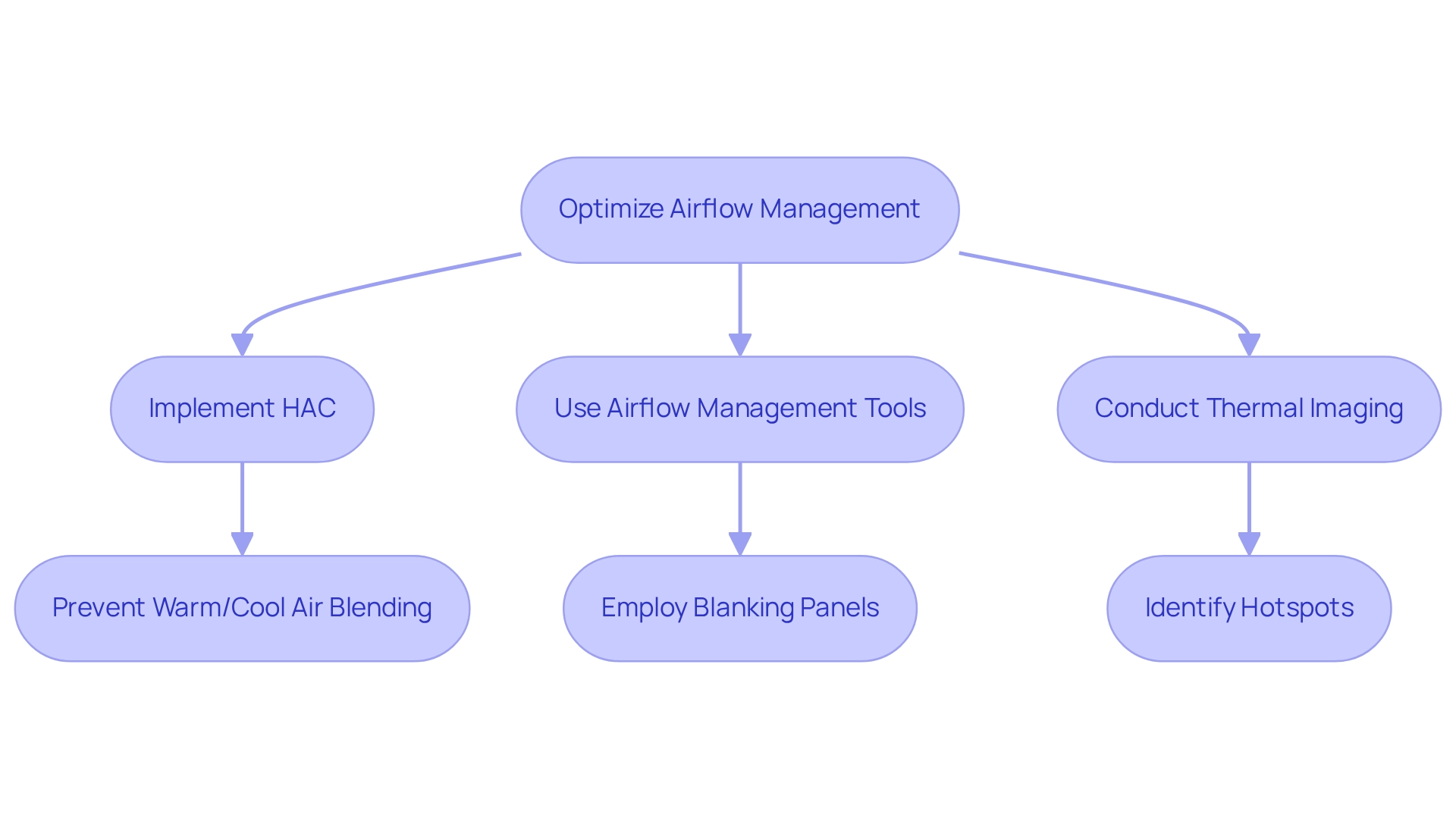
Implement Temperature Monitoring Systems: Ensure Optimal Conditions
Establishing temperature tracking mechanisms is crucial for sustaining ideal conditions in server cooling environments. These frameworks utilize a network of , providing real-time information on temperature variations. By integrating advanced monitoring solutions with building management systems, organizations can automate server cooling temperature responses, ensuring that levels remain within safe boundaries. This proactive approach not only prevents potential damage to equipment but also enhances operational efficiency.
For instance, IoT temperature monitoring has been shown to significantly reduce utility expenses by optimizing server cooling mechanisms, illustrating the economic advantages of efficient temperature management. A case study highlights how real-time information can reveal patterns indicative of potential failures, enabling organizations to address temperature issues early and avert costly breakdowns.
As we approach 2025, the importance of these frameworks continues to grow, with numerous organizations recognizing their role in extending the lifespan of IT infrastructure and ensuring seamless operations. Furthermore, industry trends indicate a heightened focus on regulatory compliance and the need for innovative solutions to meet evolving standards, making temperature monitoring tools an essential component of modern information facility management.
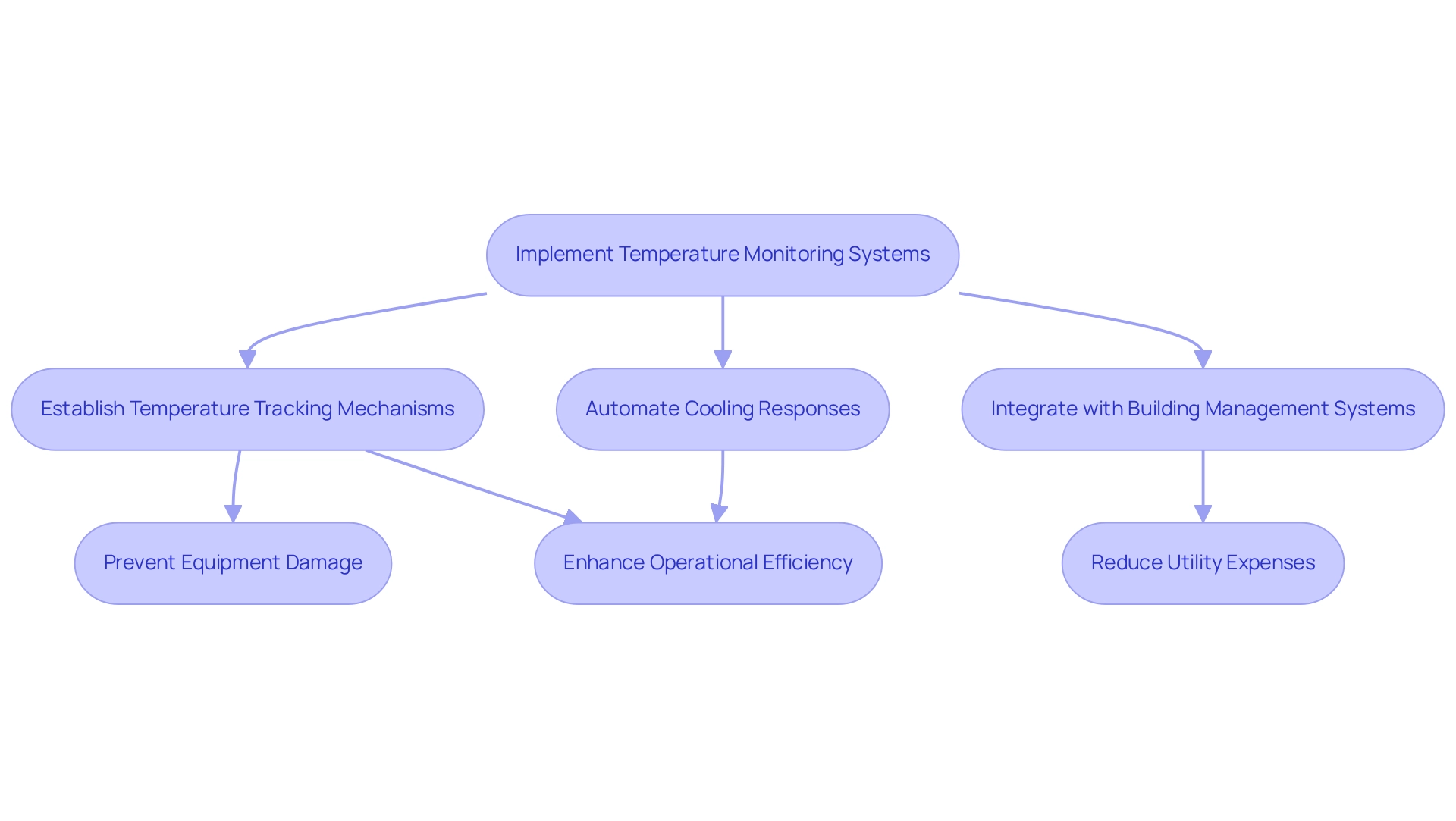
Utilize Liquid Cooling Systems: Maximize Heat Dissipation
Liquid temperature regulation setups, including direct-to-chip and immersion methods, provide substantial advantages over traditional air temperature management techniques, particularly in data centers where effective server cooling is essential to meet escalating thermal demands. These systems excel in server cooling by circulating coolant directly to heat-generating components, effectively sustaining lower temperatures and improving overall energy efficiency. Notably, conventional air-ventilation techniques falter when thermal design power (TDP) exceeds 250-280 W and rack-level heat generation surpasses 100 kW, underscoring the critical need for .
As we approach 2025, information facilities are increasingly adopting server cooling methods like liquid temperature regulation to bolster high-performance computing applications, thereby mitigating the risk of thermal throttling. For instance, direct-to-chip thermal management in server cooling presents remarkable benefits by addressing heat at its source, leading to enhanced performance and energy savings. A significant case study illustrates the implementation of a rear-door heat exchanger for rack temperature control, functioning similarly to a car radiator, effectively extracting heat from servers and optimizing server cooling throughout server facilities.
The efficacy of liquid temperature regulation methods in server cooling is evidenced by their ability to significantly reduce energy consumption. Recent evaluations by Zhang and Jiaxiang Dong indicate that these frameworks can yield substantial energy savings, rendering them an attractive option for contemporary information hubs. Moreover, water refrigeration is being utilized for both heating and server cooling in data center buildings, showcasing the versatility of liquid temperature control technologies.
Advanced pump technologies, including solenoid and rotary boost pumps, are integral to these setups. For example, solenoid pumps can operate up to 16 Bar, offering precise control for effective coolant circulation, while rotary boost pumps with DC brushless motors ensure low noise operation and enhanced efficiency. These pumps are crafted from NSF and WSAS materials, ensuring compliance with industry standards and bolstering their reliability in demanding environments. As Mehmet Arik stated, “The authors declare that they have no known competing financial interests or personal relationships that could have appeared to influence the work reported in this paper,” reinforcing the integrity of the research underpinning these advancements. As the industry evolves, the integration of server cooling technologies, supported by innovative pump solutions from Gagner-Toomey Associates, will be vital for sustaining optimal performance and reliability in increasingly demanding computing environments.
Conduct Regular Maintenance: Sustain Cooling Performance
Routine upkeep of refrigeration units is essential for guaranteeing optimal functionality and durability. This maintenance encompasses:
- Regular inspections
- Filter cleaning
- Leak detection in liquid cooling setups
By establishing a structured maintenance schedule, organizations can ensure that all components function efficiently while minimizing the risk of unexpected failures and costly downtime. A properly maintained A/C unit balances humidity levels, which supports fresher air and a healthier environment—critical factors for server cooling in data centers.
Moreover, proactive maintenance practices related to server cooling have been shown to significantly reduce energy consumption, translating into substantial savings over time. For instance, case studies indicate that organizations emphasizing regular maintenance experience fewer disruptions and enhanced reliability. One notable case study, titled ‘Long-Term Savings through Proactive Maintenance,’ illustrates how investing in expert climate control services can yield considerable long-term savings by ensuring that units operate efficiently and dependably.
By adhering to best practices, such as:
- Regular filter replacements
- Equipment checks
- Providing continuous training for clients to manage and maintain advanced temperature control units
Engineers can ensure their solutions remain effective and sustainable. This commitment to upkeep not only meets the performance requirements of contemporary information hubs but also aligns with the , particularly as we approach Earth Day.
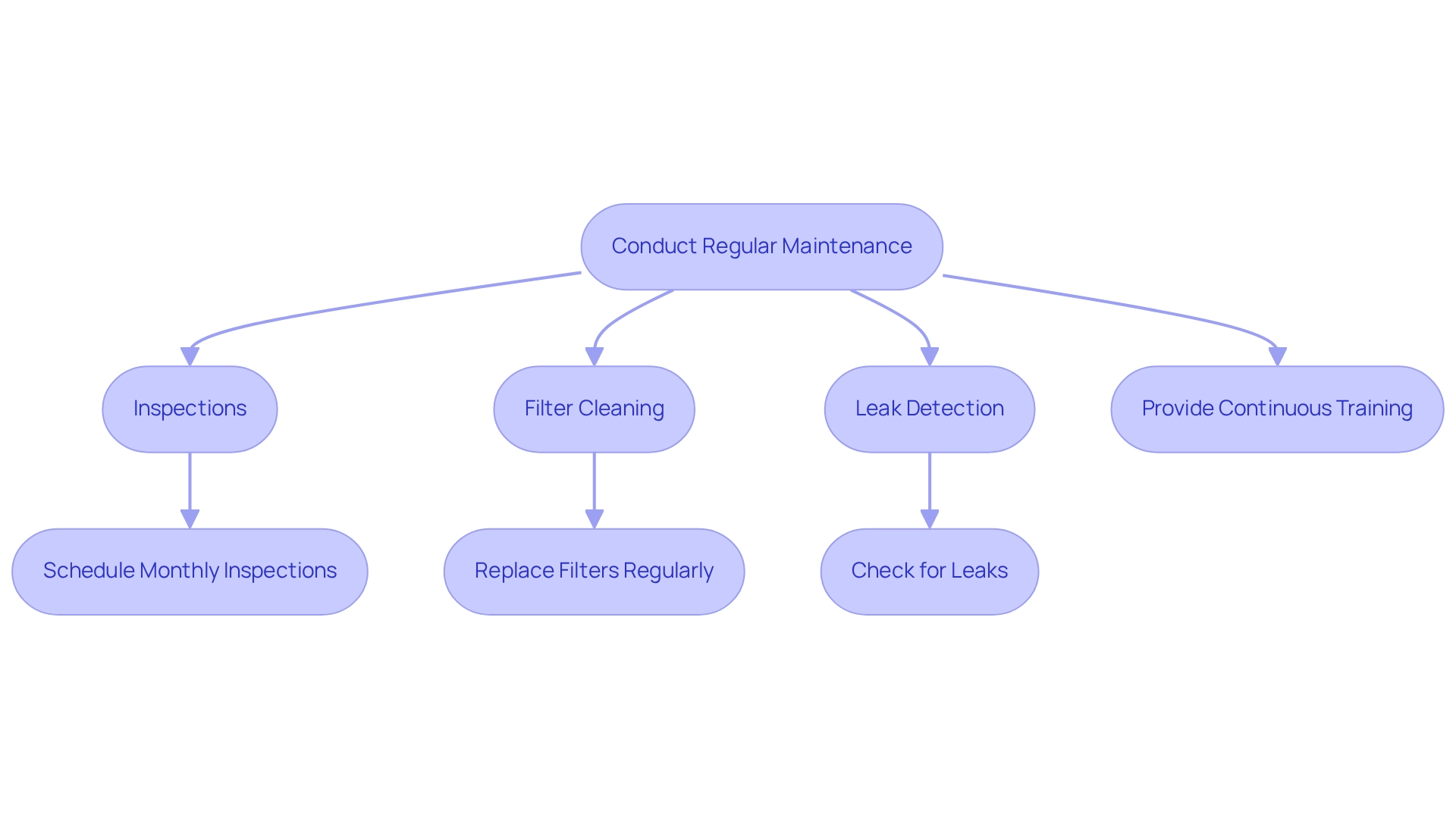
Adopt Energy-Efficient Cooling Technologies: Reduce Costs and Impact
Implementing energy-efficient temperature control technologies, such as variable speed fans and advanced chiller systems, is essential for effective server cooling and achieving substantial reductions in energy consumption within data centers. These innovations not only reduce operational expenses but also support sustainability objectives by minimizing the carbon footprint associated with server cooling processes. For instance, variable speed fans adjust their speed based on real-time cooling demands, leading to significant energy savings. Facilities that have embraced these technologies report energy consumption reductions of up to 30%, showcasing the potential for improved efficiency in server cooling.
As highlighted by Fatih Birol, IEA Executive Director, “The doubling energy efficiency goal was also the focus of other international meetings across 2024.” This underscores the necessity of technological innovation and accelerated deployment to meet ambitious energy efficiency targets. Continuous monitoring of energy use is crucial, as it provides insights into inefficiencies and supports data-driven decision-making. By assessing current infrastructures and contemplating enhancements to more effective options, facilities can not only comply with evolving but also achieve long-term financial savings. This proactive approach aligns with the broader context of energy efficiency goals and demonstrates a commitment to operational excellence.
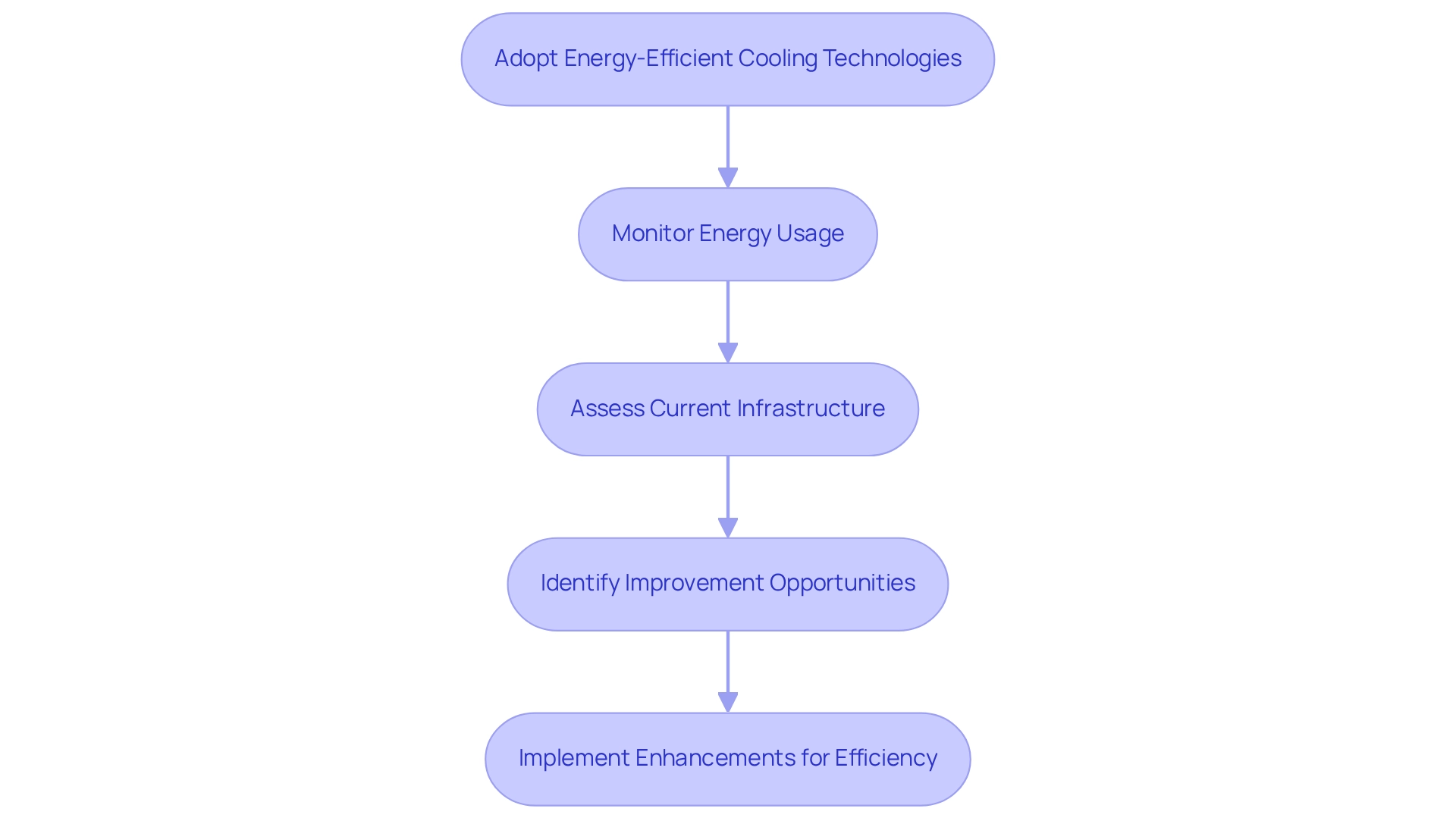
Integrate Smart Cooling Solutions: Leverage AI for Optimization
Incorporating intelligent temperature regulation solutions that employ artificial intelligence significantly enhances the effectiveness of server cooling management. By utilizing AI algorithms to assess real-time information from temperature sensors, these systems can dynamically adjust outputs, ensuring energy is used only when necessary. This proactive approach not only enhances server cooling performance but also results in substantial energy savings.
Notably, the U.S. information hub refrigeration market is witnessing strong growth, driven by the increasing implementation of . Successful implementations of AI in temperature regulation systems have shown that these technologies can effectively predict and manage workloads, optimizing resource allocation for server cooling and reducing operational costs.
For instance, AI can streamline environmental management and identify energy-intensive processes, contributing to a reduced carbon footprint and enhanced energy efficiency in computing facilities. As James Schneider, a senior equity research analyst, observes, ‘As we progress further up from the ‘infrastructure layer’ into the ‘AI model/platform layer’ and, ultimately, the ‘application layer,’ the hyperscalers’ ability to generate a return on this compounded level of capex has become increasingly top of mind for investors.’ This underscores the financial importance of adopting AI technologies.
Furthermore, companies in regions such as San Jose, Oakland, Sacramento, Los Angeles, San Diego, and Walnut Creek are increasingly adopting these smart climate control solutions, indicating the potential for significant cost savings and improved sustainability. Additionally, the case study titled ‘AI Solutions for Energy Efficiency in Data Centres’ demonstrates how AI can enhance energy efficiency by predicting and managing workloads, further reinforcing the argument for these innovative solutions.
Ensure Redundancy in Cooling Systems: Prevent Failures
Ensuring backup in server cooling setups is vital for protecting data center functions against possible failures. Implementing N+1 or 2N redundancy models for server cooling involves installing extra temperature regulation units that can seamlessly take over if a primary unit fails. This approach significantly boosts reliability, allowing for and effective server cooling even during maintenance or unexpected outages.
For instance, setups designed with N+1 redundancy in server cooling ensure that operations remain uninterrupted, as they can sustain functionality even if one component requires servicing. Motivair’s temperature control systems exemplify this with their active redundancy and resiliency features, which are crucial for server cooling and maintaining operational integrity. This level of resilience not only improves operational efficiency but also instills confidence in the server cooling systems.
As emphasized in the case study named ‘Effective Risk Communication,’ efficient communication regarding risk management between leadership and operational teams is essential for aligning temperature control strategies with business requirements, ultimately resulting in more resilient performance of the facility.
Anthony Hatzenbuehler, SVP of Data Center Operations, emphasizes that understanding specific business needs is vital for ensuring that operational strategies align with actual requirements. In 2025, the focus on server cooling in temperature regulation remains crucial, with successful applications of N+1 or 2N models showcasing their efficiency in preserving ideal conditions for vital server environments.
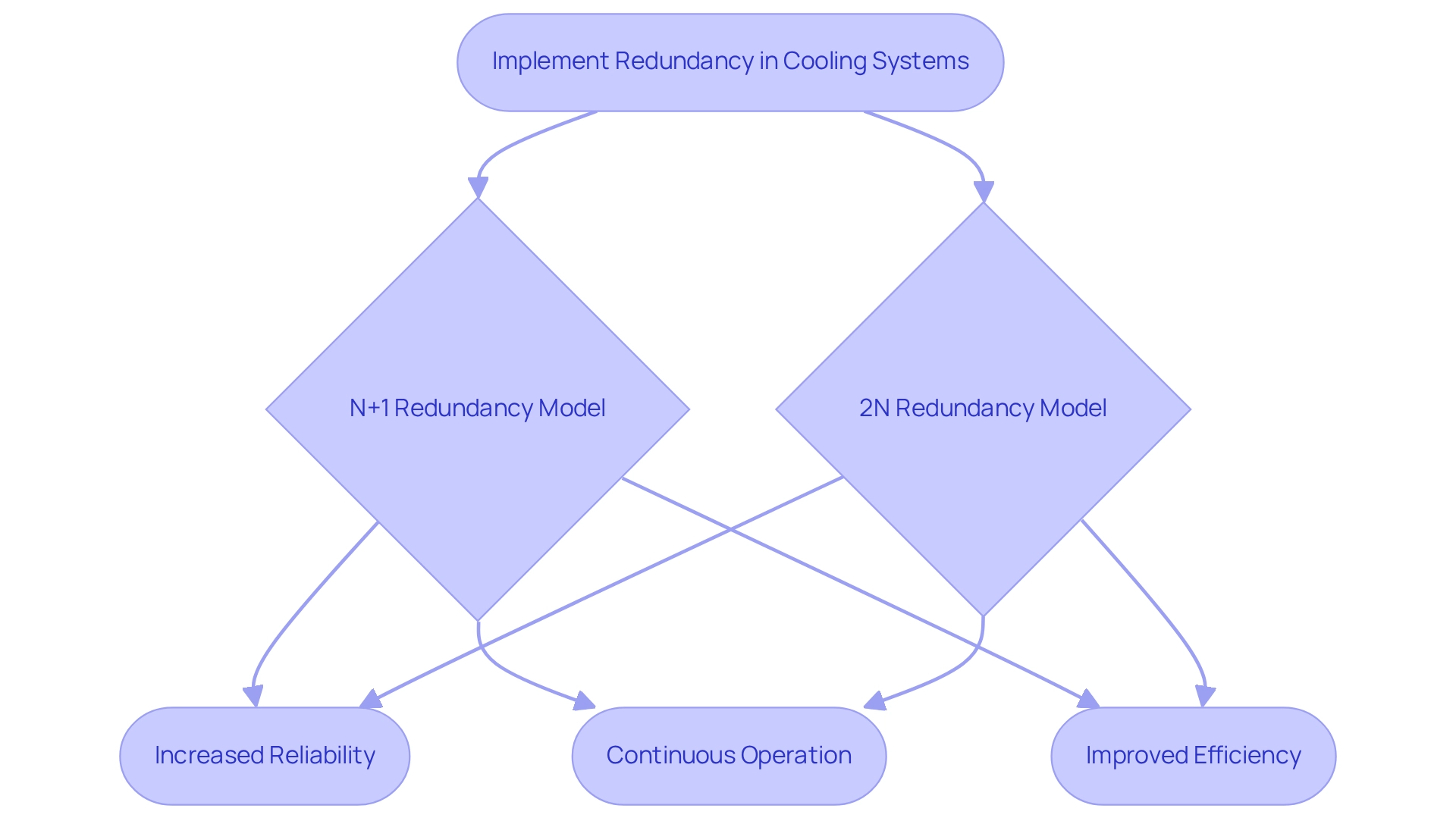
Enhance Insulation and Sealing: Improve Cooling Efficiency
Improving insulation and sealing in data centers is essential for enhancing server cooling efficiency. By effectively minimizing air leaks and preventing cooled air from escaping, facilities can enhance server cooling, which allows them to achieve lower operational temperatures while consuming less energy. High-quality insulation materials and advanced sealing techniques not only reduce energy expenses but also enhance overall performance.
Gagner-Toomey Associates, the world’s largest producer of standard and custom air-movers, offers a comprehensive portfolio of innovative temperature regulation solutions. This includes:
- Liquid temperature management systems
- Thermal management products designed specifically for electronics
Their product line features:
- DC input Tube Axial fans ranging from 15 to 280mm
- Centrifugal Blowers from 15 to 225mm, all optimized for performance and efficiency
Recent studies suggest that addressing air leaks can lead to significant enhancements in server cooling efficiency, with some implementations reporting energy savings of up to 30%. As highlighted in the case study ‘Future of Data Center Design and Cooling Infrastructure,’ the design of data centers is evolving to support higher rack-power densities, necessitating .
Successful applications of high-quality insulation materials have demonstrated that facilities adopting these practices experience improved server cooling and lower operational expenses. Christopher Tozzi, a technology analyst, observes, “They’re expensive in comparison to conventional, air-based temperature regulation, but they result in considerably reduced energy expenses.” This underscores the essential role of insulation in contemporary information hub architecture, further enhanced by Gagner-Toomey Associates’ innovative temperature regulation solutions.
Train Staff on Cooling Management: Equip for Efficiency
Training personnel on and temperature management practices is crucial for optimizing data center operations. By educating staff on temperature monitoring, airflow management, and maintenance protocols for server cooling, organizations empower their teams to proactively identify potential issues and implement best practices. Regular training sessions not only enhance staff competency but also significantly improve the efficiency of server cooling systems.
Statistics indicate that organizations with robust training programs experience a notable increase in operational efficiency; some studies reveal up to a 30% decrease in energy expenses related to server cooling and temperature control. This reduction is particularly significant given that U.S. electricity demand is projected to rise by approximately 2% annually over the next 25 years, driven by information hubs and the electrification of transportation.
Furthermore, successful case studies, such as ‘The Role of Existing Information Hubs in Sustainability Goals,’ demonstrate that existing facilities can meet sustainability objectives through retrofitting and staff education, thereby facilitating the transition to advanced server cooling technologies like two-phase direct-to-chip cooling.
As Steven Carlini, vice president of innovation and data center at Schneider Electric, remarked, ‘The rapid increase in computing power means data centers on the bleeding edge today may rapidly fall behind.’ Therefore, investing in staff training is pivotal for maintaining competitive performance and aligning with corporate sustainability objectives.
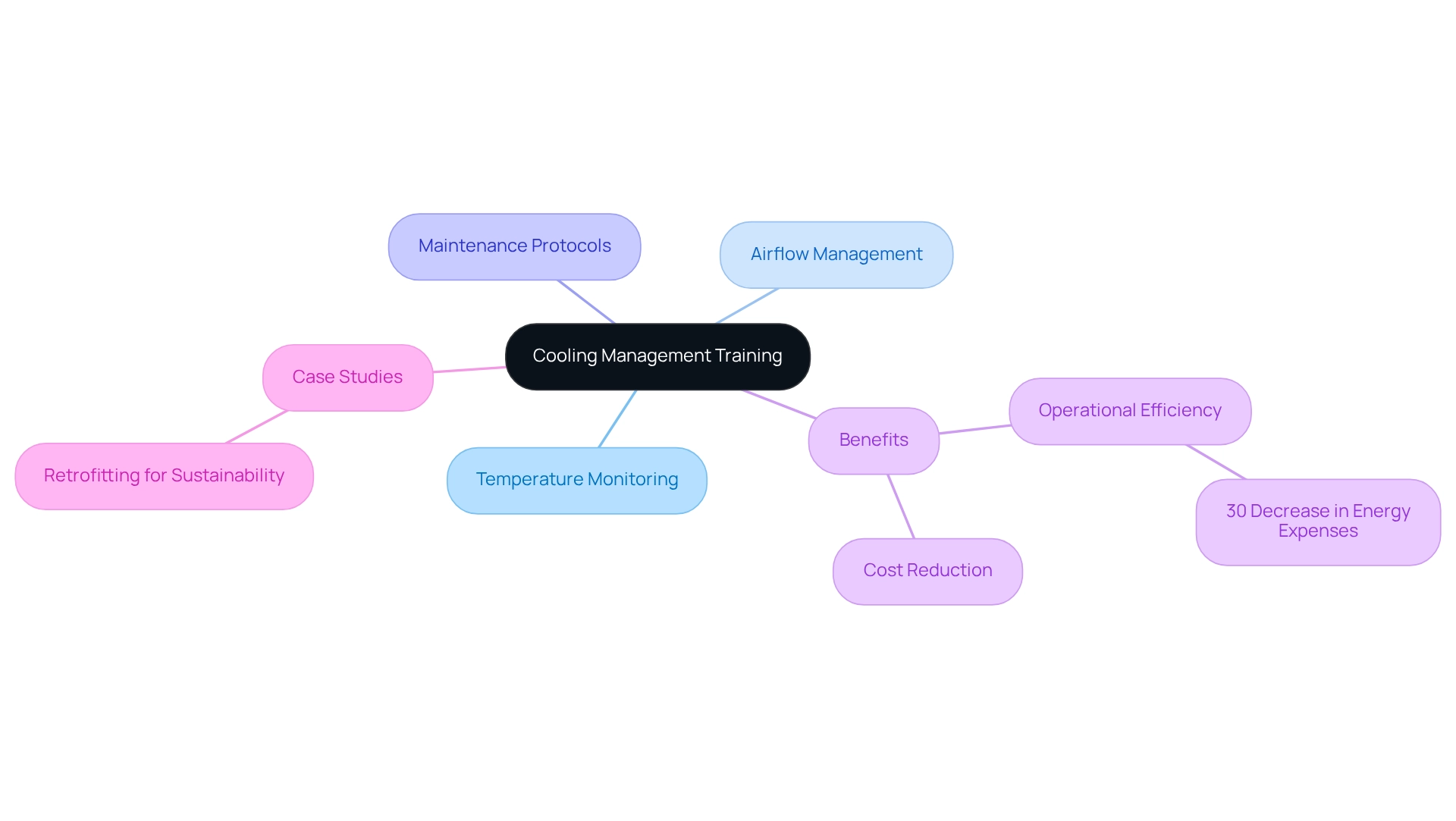
Conclusion
The landscape of data center cooling is experiencing a transformative shift, propelled by an urgent need for efficiency and sustainability. Gagner-Toomey Associates stands at the forefront of this evolution, delivering innovative cooling solutions that not only enhance performance but also significantly minimize environmental impact. As emphasized, liquid cooling systems, smart technologies, and efficient airflow management are critical components in addressing the demands of high-density computing environments. The growing adoption of these advanced technologies paves the way for data centers to operate more sustainably while achieving optimal performance.
Regular maintenance, temperature monitoring, and the integration of energy-efficient technologies further reinforce the foundation for reliable data center operations. By implementing these strategies, organizations can ensure that their cooling systems operate effectively, reducing downtime and maximizing energy savings. Moreover, emphasizing staff training in cooling management practices empowers teams to proactively tackle potential issues, resulting in enhanced operational efficiency.
Looking toward 2025 and beyond, the significance of adopting cutting-edge cooling solutions cannot be overstated. The anticipated growth in demand for data center cooling solutions highlights the necessity for organizations to remain informed and adapt to the evolving landscape. By investing in innovative technologies and sustainable practices, data centers can not only meet the increasing thermal challenges but also contribute to a greener, more efficient future. Embracing these advancements is not merely a strategic advantage; it is a critical step toward ensuring resilience in an ever-changing digital world.
Frequently Asked Questions
What solutions does Gagner-Toomey Associates provide for server cooling?
Gagner-Toomey Associates delivers cutting-edge temperature control solutions tailored for information infrastructures, addressing the unique challenges of high-density computing environments.
How does Gagner-Toomey Associates ensure reliability and efficiency in their solutions?
The company collaborates with a diverse range of manufacturers to offer advanced technologies that enhance performance, reliability, and efficiency, which are critical for maintaining optimal operating conditions in data centers.
What recent trends are influencing temperature regulation in data centers?
There is a growing focus on environmentally-friendly temperature regulation technologies, particularly liquid temperature control solutions, known for their superior energy efficiency and reduced climate impact.
What is the significance of the partnership between Danfoss and major tech companies?
Danfoss has pioneered extensive refrigeration technologies, including liquid temperature regulation solutions, in collaboration with companies like IBM, showcasing advancements that bolster sustainability in information hubs.
What recent collaboration highlights the importance of efficient server cooling systems?
The partnership between Fujitsu and Microsoft, announced in May 2023, marks a significant step towards sustainability transformation in cloud migration, emphasizing the need for effective server cooling systems.
What is the projected market growth for refrigeration solutions in information hubs?
The market for information hub refrigeration solutions is expected to grow at a rate exceeding 10% annually through 2025.
What innovative approach is being explored in Nordic nations regarding waste heat?
The concept of waste heat repurposing represents an advancement towards sustainability in the computing industry, emphasizing the global impact of innovative temperature management solutions.
What is hot aisle/cold aisle containment (HAC), and why is it important?
HAC is a method for effective airflow management in data centers that prevents the mixing of warm and cool air, significantly improving temperature control and potentially doubling the efficiency of CRAC/CRAH units.
How can airflow management tools enhance server cooling efficiency?
Tools like blanking panels and elevated floors can improve system efficiency, while routine thermal imaging evaluations help detect hotspots and optimize temperature regulation resources.
What are the benefits of implementing server cooling strategies like HAC?
These strategies enhance temperature management, conserve energy, and boost overall facility efficiency, leading to increased capacity utilization and improved system reliability.
Why is establishing temperature tracking mechanisms essential?
These mechanisms provide real-time information on temperature variations, allowing organizations to automate cooling responses and prevent potential equipment damage, thus enhancing operational efficiency.
How can IoT temperature monitoring reduce utility expenses?
By optimizing server cooling mechanisms, IoT temperature monitoring can significantly reduce utility costs and reveal patterns that indicate potential failures, enabling early intervention.
What trends are influencing the importance of temperature monitoring tools?
With approaching regulatory compliance requirements and the need for innovative solutions, temperature monitoring tools are becoming essential for modern information facility management.

